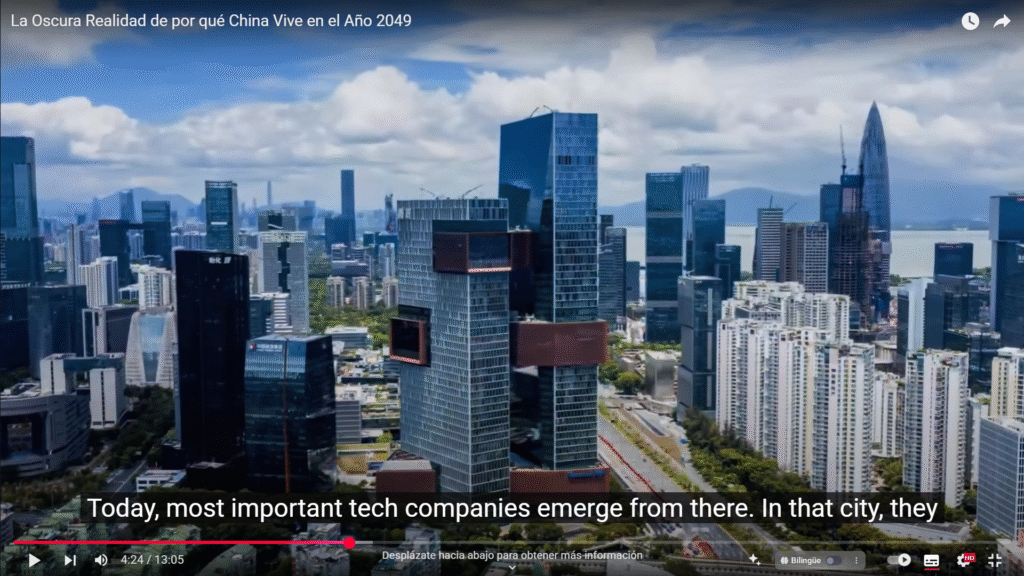Is China living in the year 2049? This is how the Asian giant was decades ahead of the rest of the world.
When we think about the future, we often imagine it filled with supersonic trains, mobile payments at every turn, and smart cities dominated by artificial intelligence. The surprising thing is that this scenario isn’t a fantasy, but the everyday reality of millions of people in China. How has it been possible for a country that just 30 years ago had more than 60% of its population living in poverty to become a global technological leader today?
In this article, we unravel the phenomenon of Chinese development, its enormous urban and technological transformation, and the sacrifices involved in this colossal leap into the future. We tell you how China is building a model nation with very clear goals for the year 2049, and why, for many, it’s already living there.
What does it mean that China “lives in the future”?
The claim that China “lives in the future” isn’t just a catchy phrase, but an increasingly common observation among visitors to the country. Landing in a city like Shenzhen or Shanghai is like entering an ultramodern dystopia: high-speed trains, facial recognition cameras on every corner, drones delivering food, and a completely digitalized economy.
With over 66% of the world’s high-speed rail lines, 700 million surveillance cameras, and a digital ecosystem led by super apps like WeChat , China has reinvented the way its citizens interact with the state, businesses, and each other.
But all this didn’t happen overnight. It was the result of decades of strategic planning and highly questionable decisions from an ethical and environmental perspective.
Key benefits of the Chinese development model
- World-Class Infrastructure
In less than 30 years, China has built entire cities from scratch. Today, there are more than 700 cities in the country, 17 of them considered megacities with tens of millions of inhabitants. Impeccable highways, magnetic trains, and an unbeatable logistics system make getting around China fast, efficient, and futuristic. - Complete digitalization of daily life.
Through apps like WeChat and AliPay , Chinese citizens don’t need cash or cards. Everything—from paying rent to scheduling a doctor’s appointment—is done from a mobile phone, with QR codes as universal currency. - Advanced Citizen Security
Although the surveillance system generates much controversy, it has reduced crime by 60% over the last 20 years. AI analyzes people’s behavior in real time, detects anomalous patterns, and automatically alerts authorities. - Eradication of Mass Poverty
In 1990, more than 60% of the population lived below the poverty line. In 2020, that number had fallen to 1%. A historic feat, driven by accelerated industrialization and planned investment. - Unprecedented economic growth.
China has transformed itself from the world’s factory into a technological leader. Chinese companies dominate sectors such as telecommunications, artificial intelligence, and electric vehicles, displacing Western giants.
Steps that led China to the “future”
- Economic reforms in 1978.
Under the leadership of Deng Xiaoping, China opened its economy to the world. Special economic zones like Shenzhen were created, attracting massive foreign investment. - Conversion to the global factory.
Multinationals moved their production to China for its cheap labor. The country capitalized on this move and reinvested in infrastructure and technology. - Tight but Effective State Control
Through a unique model that combines political communism with economic capitalism, the Chinese government centralizes national development as if it were a mega-company, where the Communist Party is the CEO. - Social and environmental sacrifice.
The strategy came at a high human cost: grueling workdays (like the infamous 996 model), forced displacement, and massive environmental pollution. China was the world’s largest emitter of CO₂ for decades. - International Expansion
To secure resources, China invested in Africa, Asia, and Latin America. Although some view this as neocolonialism, the country has gained global influence in infrastructure, trade, and diplomacy. - Investment in technology:
Much of the capital accumulated was allocated to research and development. Today, China leads the way in artificial intelligence, robotics, renewable energy, and autonomous transportation. - Establishing the 2049 Plan
On the occasion of the centenary of the founding of the People’s Republic of China, the country has set itself the goal of becoming the world’s leading power, achieving carbon neutrality, and exporting technology and innovation as a global leader.
Recommendations for understanding (and adapting to) the new China
- Analyze the model without ideological bias. China’s transformation breaks with the classic categories of left and right. It is a hybrid and pragmatic system.
- Learn from their long-term vision. While many democracies change course every four years, China follows a plan that’s been in place for more than 70 years.
- See how technology can shape society. From the use of super apps to total control of the urban environment, China shows how digitalization can redefine everyday life.
- Recognize the costs. Progress has been accompanied by repression, censorship, labor exploitation, and environmental damage. It’s not an ideal model, but it is effective.
- Prepare for a new world order. China is not just an emerging power. It is increasingly the linchpin of a new technological and geopolitical era.
Would you like to live in the future? Then it’s time to look to the East.
While the rest of the world debates politics, polarization, and broken promises, China is moving steadily toward a clear vision of the future. Not everything it has done has been fair, and many question its methods. But the truth is, the results are there: futuristic megacities, nearly eradicated poverty, and undisputed global technological leadership.
Now that you know what’s behind the so-called “year 2049,” you can reflect on where you want your society to go. Can the West learn from China? Are we ready to compete with such an aggressively efficient model?
Don’t miss the opportunity to understand this global phenomenon. Observe, question, and adapt. Because while some live in the present, others are already designing the world of tomorrow.



